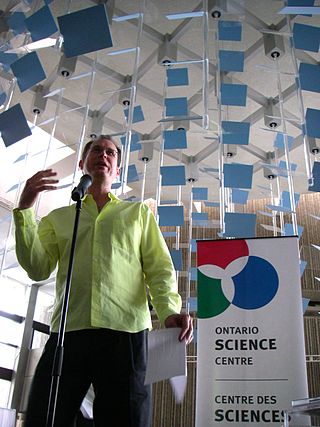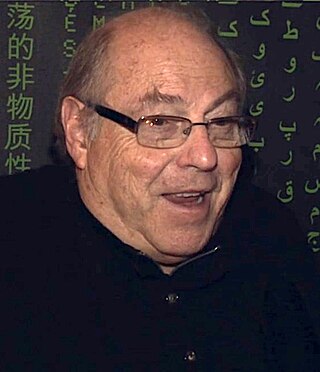

Manfred Mohr (born June 8, 1938 in Pforzheim/Germany) is a German artist considered to be a pioneer in the field of digital art. [1] He has lived and worked in New York since 1981.


Manfred Mohr (born June 8, 1938 in Pforzheim/Germany) is a German artist considered to be a pioneer in the field of digital art. [1] He has lived and worked in New York since 1981.
Mohr started his career as an action painter and jazz musician. He began using a computer in 1969 because of a growing interest in creating algorithmic art. He lived in Barcelona in 1962 and in Paris between 1963 and 1983.
His early computer works are algorithmic and based on his former drawings with a strong attitude on rhythm and repetition. In 1990 he was awarded the Prix Ars Electronica (Golden Nica) at the Ars Electronica festival in Linz, Austria. He maintained an art studio in Paris from 1963 to 1983. Mohr attended Kunst + Werkschule in Pforzheim and École des Beaux-Arts in Paris.
In 1968 he co-founded the seminar "Art et Informatique" at the University of Vincennes and in May 1971 had a solo exhibit at ARC - Musée d'Art Moderne de la Ville de Paris. [2] That exhibition has become known historically as the first solo show in a museum of works entirely calculated and drawn by a digital computer.
Recent solo exhibitions of his work include Art Basel "Art Features" with bitforms gallery in Basel, [3] DAM Gallery in Berlin, Mueller-Roth Gallery in Stuttgart, Carroll / Fletcher Gallery in London, bitforms gallery in New York City, Galerie Charlot in Paris, [4] the Museum of Kulturspeicher in Würzburg, and Galerie Wack in Kaiserslautern.
Major retrospectives of his work include ZKM | Media Museum in Karlsruhe in 2013, [5] the Kunsthalle in Bremen in 2007, Joseph Albers Museum in Bottrop, Germany in 1998, and the Wilhelm-Hack-Museum in Ludwigshafen, Germany in 1987.
Mohr's work is collected by the Centre Pompidou in Paris, the Joseph Albers Museum, the Ludwig Museum in Cologne, the Museum for Concret Art in Ingolstadt, the Kunstmuseum Stuttgart, Musee d’Art Contemporain and Musée des Beaux-Arts in Montreal, the Stedelijk Museum in Amsterdam, Musée de l'Élysée in Switzerland, and many others. Mohr has had numerous solo exhibitions in both museums and galleries in New York, Zürich, Cologne, Paris, Amsterdam, Stuttgart, Berlin, Montreal, São Paulo, and Seoul. Additionally, he has participated in group exhibitions at the Leo Castelli Gallery and at the Museum of Modern Art in New York.
Mohr has received many awards including the 2013 ACM SIGGRAPH Distinguished Artist Award for Lifetime Achievement in Digital Art, [6] 2006 (ddaa) Digital Art Award Cologne/Berlin, [7] a fellowship from New York Foundation for the Arts in 1997, the 1990 Golden Nica [8] from Ars Electronica in Linz, the 1990 Camille Graeser Prize [9] in Zürich, and the 1973 Ljubljana Print Biennial. In 1994, the first comprehensive monograph on his work was published by Waser-Verlag in Zürich. [10]

Karl Sims is a computer graphics artist and researcher, who is best known for using particle systems and artificial life in computer animation.

UBERMORGEN.COM is a Swiss-Austrian-American artist duo founded in 1995 and consisting of lizvlx and Luzius Bernhard. They live and work in Basel, S-chanf near St. Moritz and in Vienna, where both are professors at the University of Applied Arts Vienna.
James Lee Byars was an American conceptual artist and performance artist specializing in installations and sculptures, as well as a self-considered mystic. He was best known for his use of personal esoteric motifs, and his creative persona that has been described as 'half dandified trickster and half minimalist seer'.

David Rokeby is a Canadian artist who has been making works of electronic, video and installation art since 1982. He lives with his wife, acclaimed pianist Eve Egoyan, in Toronto, Canada.

Ryoji Ikeda is a Japanese visual and sound artist who currently lives and works in Paris, France. Ikeda's music is concerned primarily with sound in a variety of "raw" states, such as sine tones and noise, often using frequencies at the edges of the range of human hearing. Rhythmically, Ikeda's music is highly imaginative, exploiting beat patterns and, at times, using a variety of discrete tones and noise to create the semblance of a drum machine. His work also encroaches on the world of ambient music and lowercase; many tracks on his albums are concerned with slowly evolving soundscapes, with little or no sense of pulse.

Thomas Köner is a multimedia artist whose main interest lies in combining visual and auditory experiences. The BBC, in a review of Köner's work in 1997, calls him a "media artist," one who works between installation, sound art, ambient music and as one half of Porter Ricks dub techno. A noted characteristics of Köner's dark ambient style are low drones and static soundscapes evocative of desolate, Arctic places.
Tamás Waliczky (born in 1959, in Budapest, Hungary), is a Hungarian artist and animator, known for his new media art.

Valéry Grancher is a French Internet-based artist, performer, theorist, curator and lecturer.

Roy Ascott FRSA is a British artist, who works with cybernetics and telematics on an art he calls technoetics by focusing on the impact of digital and telecommunications networks on consciousness. Since the 1960s, Ascott has been a practitioner of interactive computer art, electronic art, cybernetic art and telematic art.

Brian Reffin Smith is an artist, writer, teacher and musician born in Sudbury, Suffolk, in the United Kingdom, who won the first-ever Prix Ars Electronica, the Golden Nica, in Linz, Austria, 1987. He lives in Berlin, Germany.

Maurice Benayoun is a French new-media artist, curator, and theorist based in Paris and Hong Kong.

Casey Edwin Barker Reas, also known as C. E. B. Reas or Casey Reas, is an American artist whose conceptual, procedural and minimal artworks explore ideas through the contemporary lens of software. Reas is perhaps best known for having created, with Ben Fry, the Processing programming language.
Jeffrey Shaw is a visual artist known for being a leading figure in new media art. In a prolific career of widely exhibited and critically acclaimed work, he has pioneered the creative use of digital media technologies in the fields of expanded cinema, interactive art, virtual, augmented and mixed reality, immersive visualization environments, navigable cinematic systems and interactive narrative. Shaw was co-designer of Algie the inflatable pig, which was photographed above Battersea Power Station for the 1977 Pink Floyd album, Animals.
Semiconductor is UK artist duo Ruth Jarman and Joe Gerhardt. They have been working together for over twenty years producing visually and intellectually engaging moving image works which explore the material nature of our world and how we experience it through the lens of science and technology, questioning how these devices mediate our experiences. Their unique approach has won them many awards, commissions and prestigious fellowships including; SónarPLANTA 2016 commission, Collide @ CERN Ars Electronica Award 2015, Jerwood Open Forest 2015 and Samsung Art + Prize 2012. Exhibitions and screenings include; The Universe and Art, Mori Art Museum, Tokyo, Japan, 2016; Infosphere, ZKM, Karlsruhe, 2016; Quantum of Disorder, Museum Haus Konstruktiv, Zurich, 2015; Da Vinci: Shaping the Future, ArtScience Museum, Singapore, 2014; Let There Be Light, House of Electronic Arts, Basel 2013 ; Field Conditions, San Francisco Museum of Modern Art, 2012; International Film Festival Rotterdam, 2012; New York Film Festival: Views from the Avant Garde, 2012; European Media Art Festival, 2012; Worlds in the Making, FACT, Liverpool 2011 ; Earth; Art of a Changing World, Royal Academy of Arts, London, 2009 and Sundance Film Festival, 2009.
Marcus Maeder is a sound artist, acoustic ecologist and composer of electronic music.
Sachiko Kodama is a Japanese artist. She is best known for her artwork using ferrofluid, a dark colloidal suspension of magnetic nano-particles dispersed in solution which remains strongly magnetic in its fluid. By controlling the fluid with a magnetic field, it is formed to create complex 3-dimensional shapes as a "liquid sculpture".

Ars Electronica Linz GmbH is an Austrian cultural, educational and scientific institute active in the field of new media art, founded in Linz in 1979. It is based at the Ars Electronica Center (AEC), which houses the Museum of the Future, in the city of Linz. Ars Electronica's activities focus on the interlinkages between art, technology and society. It runs an annual festival, and manages a multidisciplinary media arts R&D facility known as the Futurelab. It also confers the Prix Ars Electronica awards.

Vera Molnár was a Hungarian media artist who lived and worked in France. Molnár is widely considered to have been a pioneer of computer art and generative art and was also one of the first women to use computers in her art practice.
Monika Fleischmann is a German research artist, digital media scientist, and curator of new media art working in art, science, and technology. Since the mid-1980s she has been working collaboratively with the architect Wolfgang Strauss. As part of their research in New Media Art, Architecture, Interface Design and Art Theory, they focus on the concept of Mixed Reality, which connects the physical with the virtual world.
Monika Fleischmann and Wolfgang Strauss are renowned German new media artists. Since the mid-1980s, they have been instrumental in bridging the gap between new media art, computer science and knowledge art. Internationally recognized for their work in interactive environments, virtual reality (VR), mixed reality (MR), and knowledge discovery (KD), they are considered pioneers in new media art, community building and integrating transdisciplinary practices.